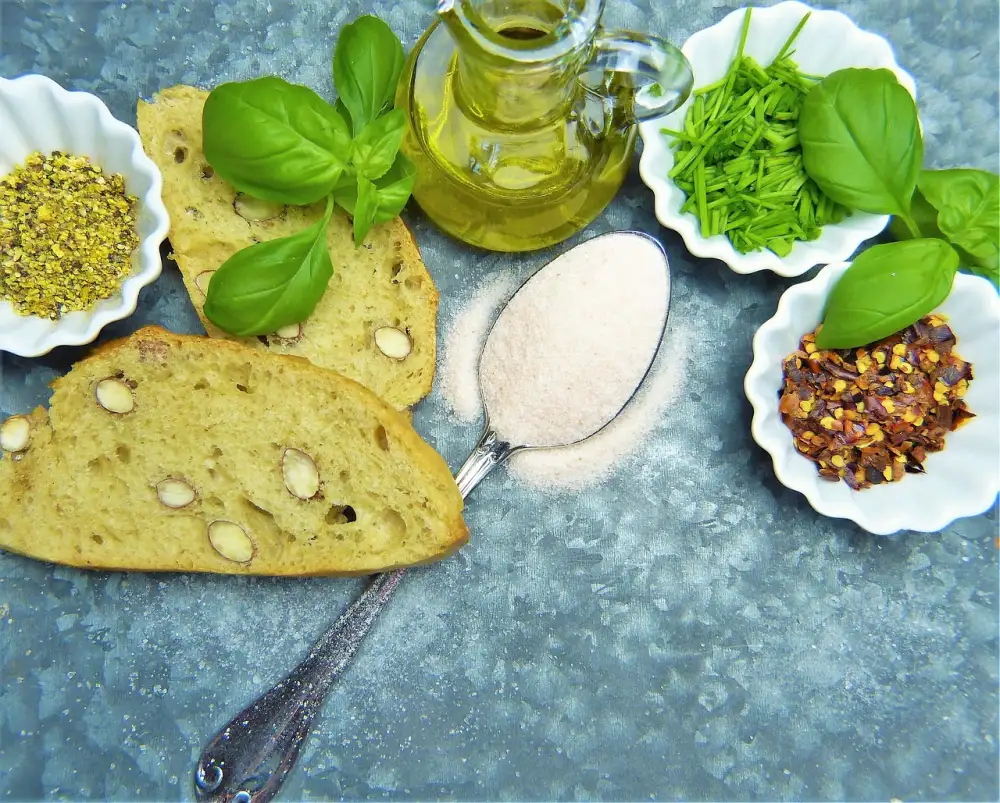Discover the Benefits of Gluten-Free Flour: A Healthier Alternative for Your Culinary Delights

- Understanding gluten and its effects on health
- Benefits of using gluten-free flour
- Types of gluten-free flours available in the market
- Nutritional value of gluten-free flour
- Tips for baking with gluten-free flour
- Incorporating gluten-free flour into a healthy diet
- Gluten-free flour alternatives for different recipes
Gluten-free flour has gained popularity in recent years as a healthier alternative for those with gluten sensitivities or celiac disease. Gluten, a protein found in wheat, barley, and rye, can cause digestive issues and inflammation in some individuals. Gluten-free flour provides an excellent substitute for traditional flour in baking and cooking, allowing people to enjoy their favorite dishes without compromising their health. Whether you have dietary restrictions or simply want to explore new culinary options, gluten-free flour opens up a world of possibilities for creating delicious and nutritious meals.
Understanding gluten and its effects on health
Gluten is a protein found in wheat, barley, and rye that gives dough its elasticity. However, for some individuals, consuming gluten can lead to various health issues. Celiac disease is an autoimmune disorder where the ingestion of gluten triggers an immune response that damages the small intestine. This can result in nutrient deficiencies, digestive problems, and even long-term complications.
Additionally, there are people with non-celiac gluten sensitivity who experience similar symptoms to those with celiac disease but do not have the same intestinal damage. These individuals may also benefit from avoiding gluten in their diet.
It's important to note that not everyone needs to eliminate gluten from their diet. However, for those with celiac disease or gluten sensitivity, it is crucial to find suitable alternatives like gluten-free flour to avoid potential health complications. By understanding the effects of gluten on health, we can make informed choices about our dietary needs and explore healthier alternatives for our culinary delights.
Benefits of using gluten-free flour
Using gluten-free flour in your culinary creations comes with a multitude of benefits. Firstly, it is a healthier alternative for those with gluten sensitivities or celiac disease. By eliminating gluten from your diet, you can alleviate symptoms such as bloating, abdominal pain, and fatigue.
Additionally, gluten-free flour can help improve digestion and nutrient absorption. It is easier for the body to break down and absorb nutrients from gluten-free grains, leading to better overall health.
Furthermore, using gluten-free flour opens up a world of possibilities for those looking to diversify their diet. It allows you to experiment with different flavors and textures in your cooking and baking. Whether you're making bread, cakes, or pastries, gluten-free flour can deliver delicious results without compromising on taste or quality.
Moreover, incorporating gluten-free flour into your diet can also promote weight loss and management. Gluten-free flours are often lower in calories and carbohydrates compared to traditional wheat flours. This makes them an excellent choice for individuals watching their calorie intake or following a low-carb diet.
Lastly, using gluten-free flour can enhance the nutritional value of your meals. Many gluten-free flours are rich in vitamins, minerals, and fiber. They provide essential nutrients like iron, magnesium, and B vitamins that contribute to overall well-being.
In conclusion, the benefits of using gluten-free flour are numerous. From improving digestive health to promoting weight management and enhancing nutritional value, this versatile ingredient offers a healthier alternative for all your culinary delights.
Types of gluten-free flours available in the market
There are several types of gluten-free flours available in the market, each with its own unique properties and flavors. One popular option is almond flour, which is made from finely ground almonds. It adds a rich, nutty flavor to baked goods and works well in recipes that require a light texture. Another common choice is rice flour, which is made from finely milled rice grains. It has a mild flavor and can be used as a substitute for all-purpose flour in many recipes. Buckwheat flour is another gluten-free option that offers a slightly earthy taste and works well in pancakes, muffins, and breads. Other gluten-free flours include coconut flour, chickpea flour, and tapioca flour, each with their own distinct characteristics. Experimenting with different types of gluten-free flours can help you find the perfect substitute for your favorite recipes.
Nutritional value of gluten-free flour
Gluten-free flour is not only a great alternative for those with gluten sensitivities or celiac disease, but it also offers several nutritional benefits. Many gluten-free flours are made from nutrient-dense ingredients such as almond, coconut, quinoa, and brown rice. These flours are rich in fiber, protein, vitamins, and minerals. They provide essential nutrients like magnesium, iron, and B vitamins that are often lacking in traditional wheat flour. Additionally, gluten-free flours are typically lower in carbohydrates and calories compared to wheat flour. Incorporating gluten-free flour into your recipes can help you create healthier and more nutritious culinary delights.
Tips for baking with gluten-free flour
When baking with gluten-free flour, there are a few tips to keep in mind. Firstly, it's important to measure the flour accurately using measuring cups specifically designed for gluten-free ingredients. This ensures the right balance of moisture and texture in your baked goods.
Secondly, gluten-free flours tend to be denser than regular wheat flour, so it's helpful to add a binding agent such as xanthan gum or guar gum. These help improve the elasticity and structure of the dough or batter.
Additionally, gluten-free flours often require more liquid than traditional flours. Be prepared to adjust your recipes by adding extra liquid, such as water or milk, until you achieve the desired consistency.
Furthermore, it's advisable to mix the dry ingredients thoroughly before incorporating them into the wet ingredients. This helps distribute the leavening agents evenly throughout the batter.
Lastly, be patient when baking with gluten-free flour. It may take longer for your baked goods to rise and brown compared to those made with wheat flour. Keep an eye on them and use a toothpick or cake tester to check for doneness.
By following these tips, you can ensure successful baking experiences with gluten-free flour and create delicious treats that everyone can enjoy.
Incorporating gluten-free flour into a healthy diet
Incorporating gluten-free flour into a healthy diet is a great way to enjoy the benefits of this alternative ingredient. Start by experimenting with small amounts in your favorite recipes, such as pancakes, muffins, or cookies. Gradually replace regular flour with gluten-free flour to ensure a smooth transition. Remember to read labels carefully and choose flours that are certified gluten-free. By incorporating gluten-free flour into your diet, you can enjoy delicious and nutritious meals while catering to your dietary needs.
Gluten-free flour alternatives for different recipes
Gluten-free flour opens up a world of possibilities for those with dietary restrictions or preferences. It can be used as a substitute in various recipes, allowing individuals to enjoy their favorite dishes without compromising their health. Here are some gluten-free flour alternatives for different recipes:
- Almond Flour: This nut-based flour is perfect for baking cookies, cakes, and muffins. It adds a rich and slightly sweet flavor to your baked goods.
- Coconut Flour: Made from dried coconut meat, this flour is ideal for pancakes, waffles, and breaded coatings. It gives a subtle coconut taste and helps create a light and fluffy texture.
- Rice Flour: Commonly used in Asian cuisine, rice flour works well in recipes that require thickening agents like sauces or gravies. It can also be used for making noodles or dumplings.
- Oat Flour: Made from ground oats, oat flour is versatile and can be used in various recipes such as pancakes, breads, and cookies. It adds a nutty flavor and helps retain moisture in baked goods.
- Chickpea Flour: Also known as gram flour or besan, chickpea flour is commonly used in Indian cooking. It works well in savory dishes like pakoras (fritters) or as a binder in veggie burgers.
- Cassava Flour: Derived from the cassava root, this gluten-free flour is an excellent alternative for wheat-based flours in recipes like tortillas, breads, and pizza crusts.
- Quinoa Flour: Quinoa flour is packed with protein and nutrients. It can be used to make gluten-free pasta, pancakes, or as a coating for fried foods.
Remember to experiment with these alternatives to find the best results for your desired recipe. Each type of gluten-free flour has its own unique characteristics that may affect the taste and texture of your final dish.
In conclusion, embracing the versatility of gluten-free flour opens up a world of possibilities for those with dietary restrictions or health concerns. By understanding the effects of gluten on our bodies and exploring the benefits of using gluten-free flour, we can create culinary delights that are not only delicious but also healthier. With a wide range of options available in the market, from almond flour to rice flour, there is no shortage of choices when it comes to experimenting with gluten-free baking. So why not give it a try and discover the endless possibilities that gluten-free flour has to offer? Your taste buds and your body will thank you!
Published: 10. 12. 2023
Category: Health



